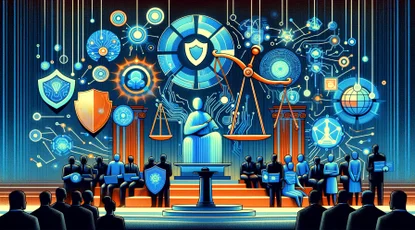The American Bar Association’s (ABA) Standing Committee on Ethics and Professional Responsibility has issued a significant opinion guiding the legal profession on the ethical use of generative artificial intelligence. As businesses and law firms increasingly integrate AI into their practices, the committee emphasizes the need for lawyers to adhere to their ethical duties when operating AI.
Ethical Obligations for AI Use
In its first formal opinion on the use of generative AI, the ABA Ethics Committee addresses the ethical challenges lawyers face when incorporating AI tools. Formal Opinion 512 explains that ethical obligations include duties to provide competent legal representation, to protect client information, to communicate with clients and to charge reasonable fees consistent with time spent using gen AI.
To manage these hurdles, lawyers should have a “reasonable understanding of the capabilities and limitations of the specific [generative artificial intelligence] technology that the lawyer might use,” the opinion says.
The 15-page opinion specifically outlined that lawyers should be mindful of a few model rules in the ABA Model Rules of Professional Conduct, including:
1. Competence (Model Rule 1.1)
Lawyers are required to provide competent representation to their clients. This involves exercising the necessary legal knowledge, skill, thoroughness, and preparation. The rule also mandates that lawyers understand the benefits and risks associated with the technologies they use, including AI tools.
2. Confidentiality (Model Rule 1.6)
Maintaining client confidentiality is paramount. Lawyers using generative AI must ensure that all information related to client representation remains confidential unless the client provides informed consent. This rule also extends to information about former and prospective clients.
3. Communication (Model Rule 1.4)
Lawyers have a duty to communicate effectively with their clients. This includes promptly advising clients of important information and reasonably consulting with them about the means to achieve their objectives. The use of AI in legal practice must not hinder this critical aspect of the lawyer-client relationship.
4. Reasonable Fees (Model Rule 1.5)
Lawyers’ fees and expenses must be reasonable. The opinion clarifies that while lawyers can charge for the time spent inputting information into AI tools and reviewing the results, they cannot typically charge clients for the time spent learning to use these tools.
Practical Implications
The ABA’s guidance calls for lawyers to have a thorough understanding of the AI technologies they employ. They must be aware of both the capabilities and the limitations of these tools to navigate potential ethical pitfalls effectively. For instance, when using AI to draft legal documents, lawyers should ensure the accuracy and completeness of the outputs before finalizing them.
Continuous Guidance and Vigilance
The ABA committee anticipates that both it and state and local bar association ethics committees will continue to provide updated guidance as AI technologies evolve. This ongoing effort is crucial to help lawyers navigate the complex ethical landscape of integrating AI into legal practice.
“With the ever-evolving use of technology by lawyers and courts, lawyers must be vigilant in complying with the Rules of Professional Conduct to ensure that lawyers are adhering to their ethical responsibilities and that clients are protected,” concludes Formal Opinion 512.
The Importance of Ethical AI Integration
The ABA’s opinion highlights the growing intersection of technology and legal ethics. As AI becomes more prevalent in legal practice, the need for clear ethical guidelines becomes increasingly important. Lawyers must balance the benefits of AI with their professional responsibilities to provide competent, confidential, and communicative representation to their clients.
The committee’s formal opinion serves as a foundational document for lawyers navigating the ethical use of generative AI. By adhering to these guidelines, lawyers can leverage AI’s capabilities while maintaining the highest standards of professional conduct.








